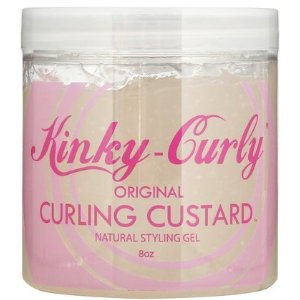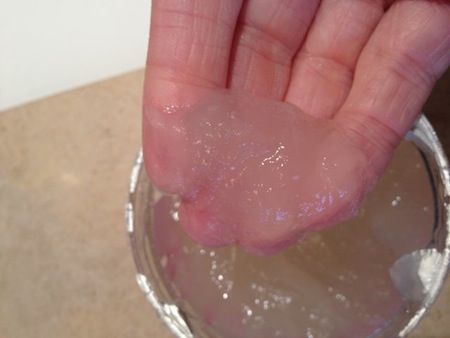Everyone who gets into the Curly Girl method develops their own routine, depending on the type of hair she has and the time of the year. Yes, what you do during summer is probably different than what you do during winter.
The Naturally Curly site refers to your hair type as 2 (wavy), 3a (lightly curly), 3b (much curliness), 3c (extreme curly), and 4 (kinky). But what your “number” is doesn’t tell you much about what your hair needs and what it will respond well to. Instead, what you need to know is what the three main elements of you hair are:
- Texture: The diameter of a strand of your hair — Fine, Medium, Coarse. Fine hair needs completely different treatment from coarse hair.
- Porosity: The ability of the hair to retain moisture. Curly hair tends to be drier than straight hair, so how much moisture it can hold — or be forced to hold — is important.
- Elasticity: The ability of the hair to stitch and return to its original length without breaking. Often an indication of whether you need more protein or less protein in your hair care regime. You can test this by taking a wet strand of hair and stretching it: it should stretch to at least 50% of its original length without breaking.
My hair is Fine, Normal porosity, and Normal elasticity. I went ahead and got a Curl Genie hair analysis from Curl Wizard anyhow, and it ended up confirming what I thought (and recommending lots of products I already used). Lots of posters on Naturally Curly have been surprised by the response they’ve gotten, so if you’re having trouble figuring out your hair, you may want to check this out.
When I started going crazy doing Curly Girl stuff I bought a LOT of hair products. (Honestly, it’s a good thing Darin doesn’t poke around in my cabinets. Or if he does, he’s kept quiet. Probably from the terror.) There are so many elements to doing one’s hair, and it’s so much fun trying different things together. I started keeping a diary of what I used on what day, the results on that day, and how it turned out the next day.
After a LOT of trial and error, I’ve found products that work really well for me. Almost all of the products have a lot of protein, because I have yet to find an upper-limit for how much protein my hair wants. Other curlies find that using protein products completely kills their hair and makes it dry and brittle. (In fact, I’ve had hairdressers tell me to avoid protein, and they’re just wrong, for my hair type.)
- Shampoo: This is very infrequent for me — maybe once a fortnight or once a month. I like Giovanni Tea Tree and Giovanni Smooth As Silk, both from Whole Foods.
- Conditioner: I use GPB and Nature’s Gate, both available from Whole Foods. I can’t even comb my hair in the shower if I don’t use a protein conditioner; otherwise, it’s too tangled and I pull half of my hair out.
- Leave-in conditioner: This tends to flatten my hair. I’ve put a dime-sized amount into super-wet hair and my hair just hangs there after it dries. You’re supposed to use this especially during winter, but that may be better advice for a colder and drier climate.
- Frizz control: I’ve only found one product for this — CHS Curl Keeper, which smells like burning tires but gives me NO frizz whatsoever.
- Curl enhancers: I know, you have curly hair already, why do you need more of it? Curl enhancers define the curl and keep them tight and springy, whereas they might droop and lose their mojo later in the day. The two I use are AG: Recoil and Pink Boots curl creme (which is a house-brand for Boots chemists and I have to import it via Britstore! But the creme is awesome and Britstore has great service, so I do it). No-Poo Jillipoo tells you how much Pink Boots to use — I use more than this, but not by much.
- Gel: This is a huge category. Light gels, medium gels, firm hold gels, extreme gels. Curlies use gels on top of gels. Some use one gel when the hair is wet and another when it’s halfway dry.
- Protein treatments: an intensive protein treatment, even for curlies who don’t need that much protein, done once a week or every two weeks. You can make your own protein treatment with unflavored gelatin.
- Deep treatments: an intensive moisturizing treatment, done once a week or every two weeks, usually right after the protein treatment.
I’m sure I’ve left a lot of categories off. But look at that! Imagine the shopping opportunities!
These days, in this very chilly and dry winter we’re having here in the Bay Area, my hair care regime is wash with conditioner, comb through, then take about a quarter-sized dollop of Pink Boots, rub it between my hands, and while bent over at the waist scrunch it up into very wet hair. I generally do a count of 6-8 scrunches to make sure the product has worked its way into my hair and is totally off my hands.
Then I follow with the single best product I use BAR NONE: Kinky Curly Curling Custard.

The first time I bought this I didn’t get how to use it. It had a weird texture and smelled kinda like vanilla and kinda…just weird. I hadn’t gone through the process of trying various things and then writing down the results. Once I did that, it was very clear what KCCC did for me: it gave me big clumpy curls that held their shape, with very little frizz.
After I apply Pink Boots (or AG: Recoil; gotta mix it up a little every so often), I take a good-sized dollop of KCCC and scrunch in it, once again doing the 6-8 count of scrunches.

A good-sized dollop
Then, depending on how it feels, I might do a second dollop, really giving the hair a good scrunching to get the product in and simultaneously squeeze the water out.
Then I use a towel to scrunch water out, and then I plop for maybe 30 minutes.
When my hair is about half-dry, I take another dollop of KCCC and scrunch it in/smooth it over the hair. This is called the Smasters method at Naturally Curly, and it doesn’t work for everyone, but it seems to add a nice layer of sheen to my hair. Then I pin everything up again and let it air dry.
Once the hair is dry, I get the fun of “scrunching out the crunch” — bending over at the waist (yes, again: you can do your hair AND practice flexibility!), and gently crushing the gel casts on my hair. The hair has absorbed the gel and will hold its shape, but I don’t have to keep the hard, crunchy gel layer. (That’s why you do all this stuff when the hair is wet.)
The downside of KCCC is that the hair can take forever to dry. I’m fairly patient, but if you’re not, here’s how to blow-dry your hair. You MUST have a diffuser, or you’re going to kill your hair.
The only way to blow-dry hair and not get the frizzies
- Load up a clump of wet hair in the diffuser.
- Hold the clump against your head so that it doesn’t move.
- Only then turn on the hairdryer.
- Leave the hairdryer against your head. Under no circumstances move the hairdryer while it’s on. If you move the hairdryer while it’s on against your hair, the hot air ruffles up the hair shaft and you have just bought frizzy hair for the day. Don’t do that. The hair must dry in place.
- When you can’t stand it any more, turn the hairdryer off.
- Then pull it away from your head.
- Repeat with a new clump of hair. You may have to redo clumps.
- When the hair is fully dry, scrunch out the crunch.
Sometimes it’s just easier to let it air dry.